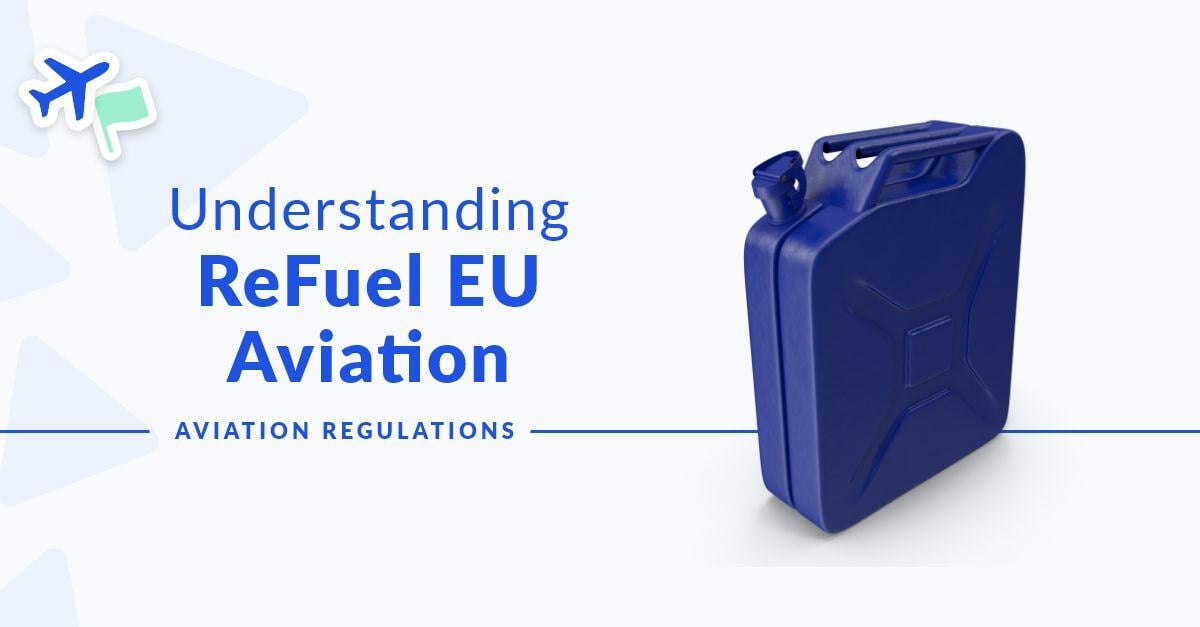Understanding the ReFuelEU Aviation regulation.
As the aviation industry grapples with the urgent need to reduce its carbon footprint, the European Union's ReFuelEU Aviation initiative emerges as a pivotal policy driving changes toward sustainability.
Let's take a closer look at this policy.
|
Summary |
What is the ReFuelEU Aviation regulation?
ReFuel EU Aviation is an important element of the European Union’s (EU) ambitious climate policy, designed to significantly reduce carbon emissions in the aviation sector by promoting the use of Sustainable Aviation Fuel (SAF).
Launched as part of the “Fit for 55” package, presented by the European Commission, a package that aims to enable the EU to reduce net greenhouse gas emissions by at least 55% by 2030 compared to 1990 levels. the objective is to achieve climate neutrality in 2050.
4 key requirements under ReFuelEU Aviation
1. Progressive increase in SAF use
ReFuel EU mandates a progressive increase in the use of SAF, starting with a 2% blend by 2025, escalating to 6% by 2030, and reaching the objective of 70% by 2050.

Share of SAF in all EU airports in 2025 and 2050
Source: European Commission
2. Obligation to avoid tankering practices
Aircraft operators are obliged to ensure that the yearly quantity of aviation fuel uplifted at a given EU airport is at least 90% of the yearly aviation fuel required to avoid tankering practices that would induce additional emissions from extra weight.
|
🔎 Tankering in a nutshell |
3. Scope of eligible SAF:
The scope of eligible sustainable aviation fuels and synthetic aviation fuels includes certified biofuels, renewable fuels of non-biological origin (including renewable hydrogen), and recycled carbon aviation fuels.
These fuels are required to comply with the Renewable Energy Directive’s (RED’s) sustainability and emissions-saving criteria.
The maximum proportion of Sustainable Aviation Fuel (SAF) and synthetic aviation fuels in the overall aviation fuel consumption is capped at 70%. This strategy is designed to encourage the adoption of sustainable and low-carbon alternatives while maintaining a balance between various types of fuel.
4. Reporting requirements:
The operators subject to ReFuel EU are required to report on the 2024 monitoring period in 2025. A third-party verifier must verify this report, which must be submitted to the respective authorities by March 31, 2025.
How to do your airline's ReFuelEu Aviation report?
As of June 2024, the reporting should be done via the ReFuelEU reporting tool.
You will have to submit your report with the following reporting templates:
1. Template to report fuel tankering.

💡 Pro tip: For this step, a predefined dashboard in your SkyBreathe® Analytics platform can help you easily report your flight-by flight tankering practice.
2. Template to report SAF purchases.

What is the penalty for ReFuelEU Aviation's noncompliant airlines?
To ensure compliance with the SAF blending and uplifting obligations, the European Commission has established criteria for non-compliance penalties. According to these guidelines, member state authorities will set penalties for fuel suppliers and airlines.
For airlines, penalties will be at least twice the yearly average price of conventional jet fuel, multiplied by the quantity of SAF that has not been uplifted.
The fuels reference prices have been released in March 2025 for the 2024 report, due by March 21st.
This stringent penalty framework enforces adherence to SAF usage mandates and drives the transition towards more sustainable aviation fuels.
What are the benefits of ReFuelEU Aviation regulation?
ReFuelEU Aviation is poised to play a critical role in helping the EU developping sustainable aviation in Europe and achieving its climate targets.
According to the EU regulation, the adoption of SAF could lead to a significant reduction in CO2 emissions, surpassing 60% by 2050 compared to 1990 levels.
Additionally, increasing the use of SAF is expected to mitigate other harmful pollutants such as carbon monoxide (CO), nitrogen oxides (NOx), and particulate matter (PM). This reduction in pollutants will notably improve air quality, particularly in areas surrounding airports, thereby contributing to a healthier environment and supporting the EU's broader sustainability goals.
To know more about ReFuelEU Aviation benefits visit the official website.

ReFuel EU Aviation benefits - Source: European Commission

LEARN MORE
[CASE STUDY] Discover VivaAerobus' impressive path to mastering fuel efficiency.
>> Download the free case study




